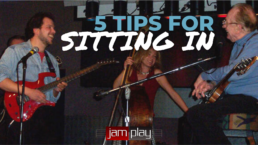5 Tips For "Sitting In" (On A Jam Session)
“Sitting in” means getting up to play with an established group as a guest.
Years ago I had the opportunity to sit in with the legendary Les Paul at his long-running regular gig at the NYC jazz club Iridium.
I was, of course, terrified, but eager to prove myself. Les introduced me by saying from the stage “there’s a kid here who says he can play”. When I walked up, he asked me what I wanted to play. I called Jimmy Smith’s “Back At The Chicken Shack”, a blues-jam standard. Given the opportunity to join in with a legend like that, I wanted to be in somewhat familiar territory. Twelve bar blues, three chords. I also knew the head melody and was prepared to lead it.
I heard later that if Les didn’t like you, he would just turn up and play over you. But instead he sat smiling and nodding, and I got a lifetime memory.
Now, I was fortunate that I was able to call the tune myself, and so wasn’t at the disadvantage of having to pick it up on the spot. As often as not, you won’t know the tune, and you’ll need to figure it out onstage.
Have you ever wondered how some people are able to jump right in and play along with a song they’ve never heard?
Good musicians can communicate without needing to speak. The ability to do this comes from active listening: reacting and responding in the moment. Familiarity with the “language” – the vocabulary that defines a musical style – is just as important. Once you know the basic vocabulary of a genre, every musical move suggests a set of possible next moves. This is why blues jams are so popular: there’s a common set of norms that are easy to follow.
Once you’ve learned a handful of blues songs, you know to listen for the move to the 4 chord. It’s often predictable (rewardingly so, when you nail it). That move is likely to be signaled by one of the other players on the stage. It might be a walk from the bass player, or a drum fill. It may have been planned and expected, or it may not. Either way, that musical interjection is a “heads-up” that a change is coming.
When you’re sitting in, this is what you listen for most.
You should be aware of the chord changes, but also the energy and dynamics of the other players and how they interact. The interplay of their parts will help you keep your place in the form and anticipate when a new section is coming. This means your first job is not to play right away, or at least, not to play very much. Lay back and listen first. Even if you can’t tell what the chords are at first, you can listen for when they happen. Listen for cycles and patterns. This is the architecture of the song, the structure. Understanding a song’s structure helps you follow the map, and know when to expect a possible new change.
“Understanding” in this case doesn’t even necessarily mean naming the chords. You also don’t need to know the theory to listen for chord changes. Paying attention is enough to begin to notice how certain chord changes are familiar and predictable. The more you listen this way, the more you’ll start to hear.
Ok, so you’re tuned up and tuned in and ready to jam! Here are some major do’s and don’ts.
1. Rule number one (that goeth before all others): when in doubt, lay out.
No one wants to listen to you fumble for the key. If you’re unsure, don’t play.
2. DO ask for the key if you aren’t sure. DON’T assume that means you know all the chords to expect.
Remember that “key” in popular music tells you the tonal center, and not necessarily whether you’re going to use strictly diatonic chords. Keep your ears open and if you’re unsure, hang back. You really don’t need to play through the entire song: pick your moments.
3. Watch your volume. Blend into the group until it’s time to step forward.
The last thing you want is to call negative attention to yourself. Be part of the background until it’s your turn. Good players are able to weave in and out, contributing flavor for a moment and then seamlessly melting back into the group sound.
4. When you do play something, commit. Play with authority or don’t play at all.
That doesn’t mean playing something fancy. We all know how the greats can be commanding with one note. Placement, attitude, and tone matter more than the scale you’re playing.
5. Watch and listen for cues! If you’re given a solo, be able to follow the form so you know when to expect the cue that signals whether or not you’ll get another chorus.
This applies in any setting, soloing or not. I’ve been on stage with alleged pros that suddenly seemed to believe they had a psychic ability to know where the song was going…and didn’t. It detracts from the performance, annoys the band, and makes you look clueless.
Remember, being asked to sit in is an honor, a statement of trust that you won’t screw things up. So treat the stage and everyone on it with respect.
Interested in more guitar lessons and courses? Check out JamPlay.com. JamPlay has over 450 guitar courses from 120+ instructors, and online guitar lessons tailored to every skill level, music genre, and playing style. Click here to learn more.
Dave Isaacs has established himself as a guitar teacher extraordinaire, having built a strong set of educational curriculums for beginner, intermediate, and advanced guitar players alike. Dave shares his expertise largely through video platforms, but also through his thoughtful writing. You can take guitar lessons from Dave Isaacs via his comprehensive video guitar courses on JamPlay.com.
Share this
Become a JamPlay member for unlimited access to 7000+ guitar lessons and 120+ artists and instructors. View membership plans ›




